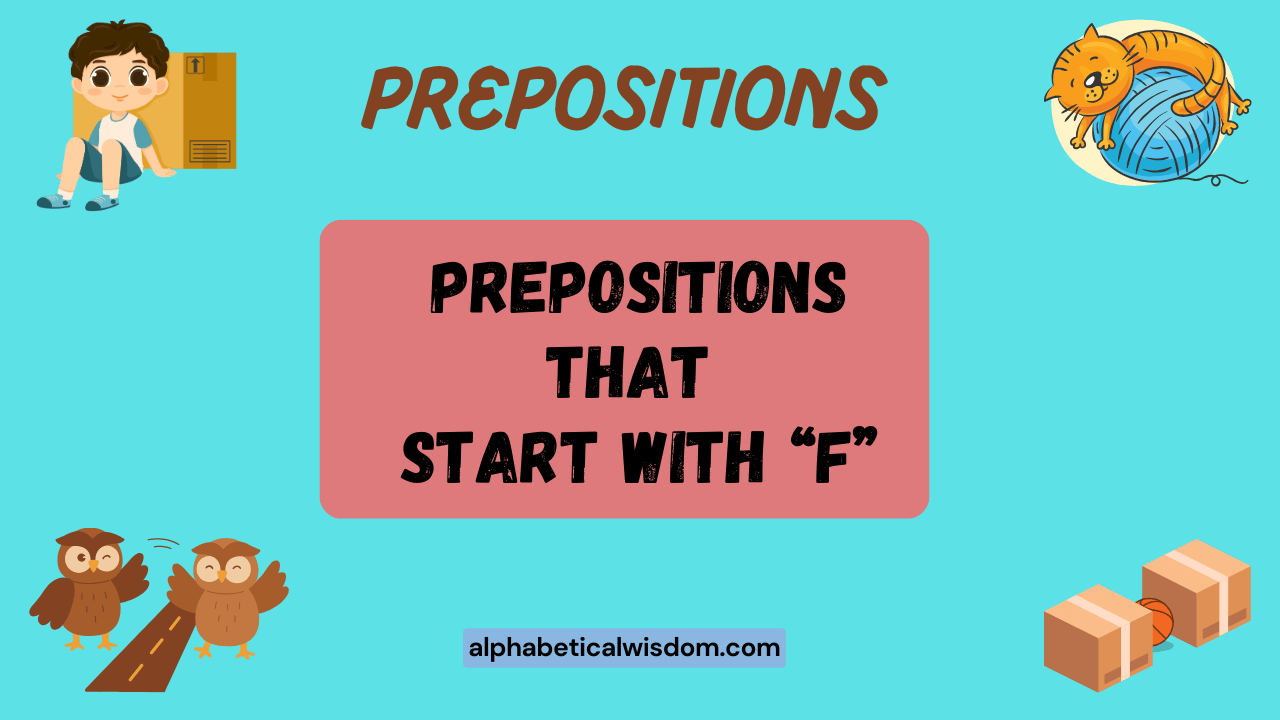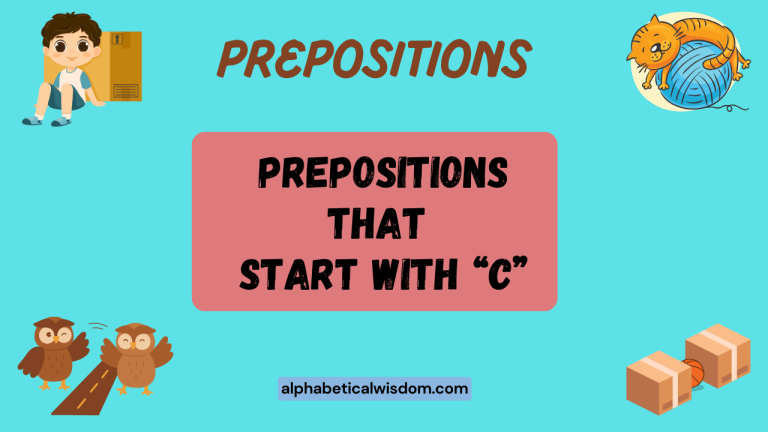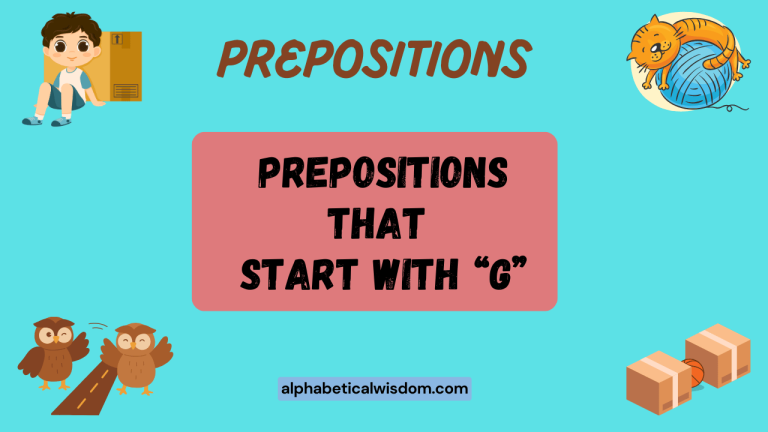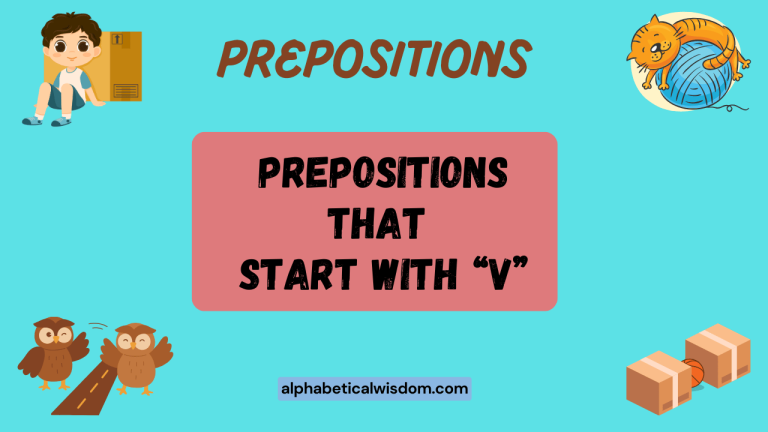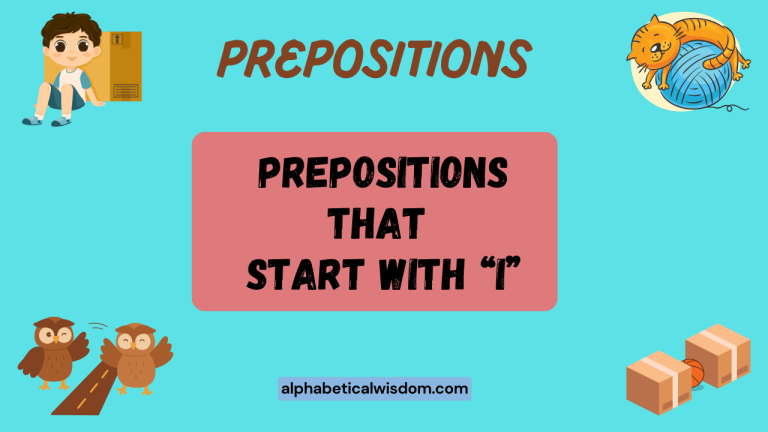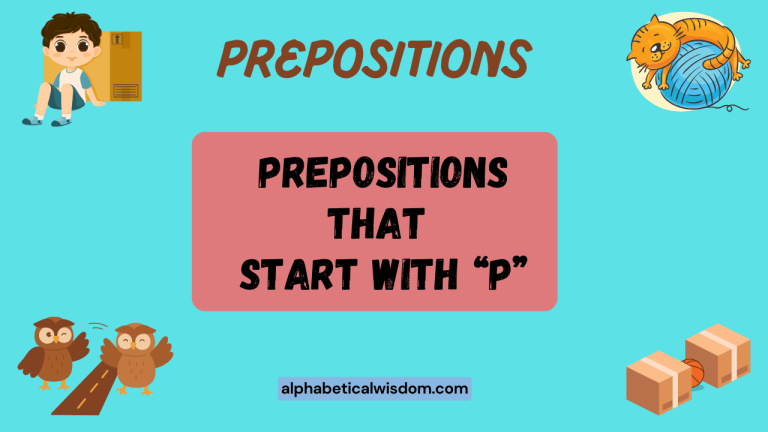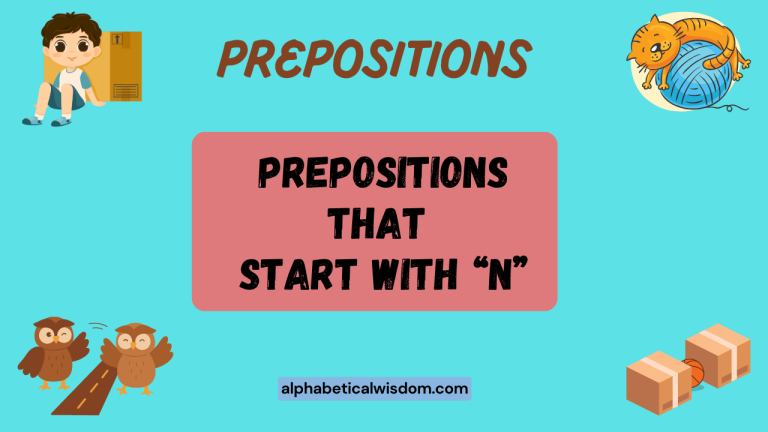Prepositions Starting with F: Mastering English Grammar
Understanding prepositions is crucial for constructing grammatically correct and meaningful sentences in English. Prepositions that begin with the letter “F,” while not as numerous as some other categories, play a vital role in expressing relationships between elements in a sentence.
Mastering these prepositions will significantly enhance your ability to communicate precisely and effectively. This article provides a comprehensive guide to these prepositions, offering definitions, examples, usage rules, and practice exercises.
This guide is ideal for English language learners of all levels, from beginners to advanced speakers, and anyone looking to refine their understanding of English grammar.
Table of Contents
- Introduction
- Definition of Prepositions
- Structural Breakdown of Prepositional Phrases
- Types and Categories of Prepositions Starting with F
- Examples of Prepositions Starting with F
- Usage Rules for Prepositions Starting with F
- Common Mistakes with Prepositions Starting with F
- Practice Exercises
- Advanced Topics
- FAQ
- Conclusion
Definition of Prepositions
A preposition is a word that connects a noun, pronoun, or noun phrase to other words in a sentence. It typically indicates the spatial, temporal, or logical relationship of the object to the rest of the sentence.
Prepositions are essential components of English grammar, providing context and clarity to our communication. They are classified as a type of function word, meaning their primary role is to indicate grammatical relationships rather than carry specific semantic content.
The function of a preposition is to introduce a prepositional phrase. This phrase consists of the preposition itself and its object, which is the noun, pronoun, or noun phrase that the preposition relates to the rest of the sentence. Prepositional phrases can act as adjectives, modifying nouns, or as adverbs, modifying verbs, adjectives, or other adverbs. Understanding the function of prepositions and prepositional phrases is crucial for accurate sentence construction and interpretation.
Prepositions appear in various contexts, expressing relationships of location (at, in, on), time (before, after, during), direction (to, from, towards), and manner (by, with, without). They also indicate relationships of purpose, cause, and possession. The specific meaning of a preposition often depends on the context in which it is used. For example, the preposition “on” can indicate location (on the table), time (on Tuesday), or a state (on fire). Therefore, careful attention to context is necessary for accurate interpretation and usage.
Structural Breakdown of Prepositional Phrases
A prepositional phrase is a group of words consisting of a preposition and its object. The object is typically a noun, pronoun, or noun phrase. The basic structure of a prepositional phrase is: Preposition + Object. For example, in the phrase “for the team,” “for” is the preposition, and “the team” is the object.
The object of a preposition can be a simple noun (for John), a pronoun (for him), or a more complex noun phrase (for the hardworking students). The noun phrase may include articles, adjectives, and other modifiers that describe the noun. Understanding the components of a prepositional phrase is essential for analyzing sentence structure and understanding the relationships between different parts of the sentence.
Prepositional phrases can function as adjectives or adverbs within a sentence. When a prepositional phrase modifies a noun or pronoun, it acts as an adjective. For example, in the sentence “The book on the shelf is mine,” the phrase “on the shelf” modifies the noun “book.” When a prepositional phrase modifies a verb, adjective, or adverb, it acts as an adverb. For example, in the sentence “He ran for the bus,” the phrase “for the bus” modifies the verb “ran,” indicating the purpose of his running.
Types and Categories of Prepositions Starting with F
While the number of prepositions starting with “F” is limited, understanding their specific uses is crucial. The primary prepositions in this category include “for,” “from,” and “following.” Each of these prepositions has distinct meanings and usage patterns.
For
The preposition “for” is used to express a variety of relationships, including purpose, duration, recipient, and cause. It is one of the most versatile prepositions in the English language. “For” can indicate the reason or purpose behind an action, the length of time something lasts, who or what benefits from something, or the cause of a particular situation or feeling.
From
The preposition “from” primarily indicates origin, source, or starting point. It is used to show where something comes from, either literally or figuratively. “From” can also denote a separation or distinction between two things. Understanding the concept of origin or source is key to using “from” correctly.
Following
The preposition “following” indicates a sequence or order in time or space. It means “after” or “next.” Unlike “for” and “from,” “following” often has a more formal tone and is frequently used in written English. It implies a direct succession or consequence.
Examples of Prepositions Starting with F
To fully grasp the use of prepositions starting with “F,” it’s essential to examine them in various contexts. The following sections provide detailed examples for each preposition, illustrating their different meanings and applications.
Examples Using “For”
The preposition “for” is incredibly versatile. The table below showcases its usage in expressing purpose, duration, recipient, and cause.
Understanding these nuances is key to mastering “for.” It is crucial to observe the context in which “for” is used to understand its specific meaning.
| Category | Example Sentence | Explanation |
|---|---|---|
| Purpose | I went to the store for milk. | Indicates the reason for going to the store. |
| Purpose | She studied hard for the exam. | Indicates the reason for her studying. |
| Purpose | He bought a gift for his mother. | Indicates the intended recipient of the gift. |
| Purpose | They are saving money for a vacation. | Indicates the reason for saving money. |
| Purpose | This tool is used for cutting wood. | Indicates the tool’s intended function. |
| Duration | We lived in Paris for three years. | Indicates the length of time they lived there. |
| Duration | The meeting lasted for two hours. | Indicates the length of the meeting. |
| Duration | She worked on the project for a month. | Indicates the duration of her work. |
| Duration | He waited for the bus for twenty minutes. | Indicates the length of his wait. |
| Duration | The movie played for over two hours. | Indicates the duration of the movie. |
| Recipient | This gift is for you. | Indicates who the gift is intended for. |
| Recipient | I made a cake for my friend. | Indicates who the cake was made for. |
| Recipient | She wrote a letter for her grandmother. | Indicates who the letter was written for. |
| Recipient | He bought flowers for his wife. | Indicates who the flowers were bought for. |
| Recipient | They sang a song for the audience. | Indicates who the song was performed for. |
| Cause | He was punished for his misbehavior. | Indicates the reason for the punishment. |
| Cause | She apologized for being late. | Indicates the reason for her apology. |
| Cause | They thanked him for his help. | Indicates the reason for their gratitude. |
| Cause | He is known for his kindness. | Indicates the reason for his reputation. |
| Cause | The city is famous for its architecture. | Indicates the reason for the city’s fame. |
| Exchange | I traded my old phone for a new one. | Indicates what was exchanged for something else. |
| Exchange | She paid $20 for the book. | Indicates the price paid for the book. |
| Exchange | He worked for a salary of $50,000 per year. | Indicates the compensation for his work. |
| Exchange | They fought for their freedom. | Indicates what they were fighting to obtain. |
| Exchange | She voted for the best candidate. | Indicates who she supported in the election. |
Examples Using “From”
The preposition “from” is used to indicate origin, source, or separation. The following table provides examples of “from” in various contexts, emphasizing its role in specifying where something originates or begins.
Understanding the different uses of “from” can help you write more precise and clear sentences. Note how “from” can indicate physical location, a point in time, or even a more abstract source of information.
| Category | Example Sentence | Explanation |
|---|---|---|
| Origin | He is from Italy. | Indicates his place of birth or nationality. |
| Origin | The wine is from France. | Indicates the country where the wine was produced. |
| Origin | She received a letter from her friend. | Indicates the sender of the letter. |
| Origin | The river flows from the mountains. | Indicates the starting point of the river. |
| Origin | This painting is from the Renaissance period. | Indicates the time period the painting originated from. |
| Source | I learned about it from a book. | Indicates the source of information. |
| Source | The quote is from Shakespeare. | Indicates the author of the quote. |
| Source | He got the idea from a movie. | Indicates the inspiration for the idea. |
| Source | The recipe is from my grandmother. | Indicates who provided the recipe. |
| Source | The news came from a reliable source. | Indicates the origin of the news. |
| Separation | Keep away from the fire. | Indicates the need to stay a safe distance. |
| Separation | He recovered from his illness. | Indicates the process of getting better. |
| Separation | She graduated from college. | Indicates the completion of her studies. |
| Separation | They resigned from their jobs. | Indicates the act of leaving their positions. |
| Separation | He retired from the army. | Indicates the end of his military service. |
| Starting Point | The store is open from 9 AM to 5 PM. | Indicates the beginning and end of the store’s hours. |
| Starting Point | The concert is from June 1st to June 10th. | Indicates the start and end dates of the concert. |
| Starting Point | He worked from home yesterday. | Indicates where he worked. |
| Starting Point | The path leads from the village to the lake. | Indicates the starting and ending points of the path. |
| Starting Point | The train departs from platform 3. | Indicates the departure location of the train. |
| Material | The statue was made from bronze. | Indicates the material used to create the statue. |
| Material | The paper is made from recycled materials. | Indicates the composition of the paper. |
| Material | The bridge is constructed from steel. | Indicates the primary construction material. |
| Material | The cake was decorated from sugar. | Indicates the ingredients used for decoration. |
| Material | The house was built from brick and stone. | Indicates the materials used in the construction. |
Examples Using “Following”
The preposition “following” is used to indicate sequence or order. In the table below, you’ll find examples demonstrating how “following” is used to show what comes after something else, whether in time or in a list.
“Following” is often used in formal contexts and written English to indicate direct succession. It suggests a clear order or progression.
| Category | Example Sentence | Explanation |
|---|---|---|
| Sequence | Following the meeting, we will have lunch. | Indicates that lunch will occur after the meeting. |
| Sequence | Following his speech, the audience applauded. | Indicates that the applause happened after the speech. |
| Sequence | Following the instructions carefully, he assembled the furniture. | Indicates that he assembled the furniture after reading the instructions. |
| Sequence | Following the rain, the sun came out. | Indicates that the sun appeared after the rain stopped. |
| Sequence | Following graduation, she plans to travel. | Indicates that she will travel after graduating. |
| Order | The items are listed following their importance. | Indicates that the order of the items reflects their importance. |
| Order | The steps should be completed following this order. | Indicates that there is a specific sequence to follow. |
| Order | The chapters are arranged following a chronological timeline. | Indicates that the chapters are ordered by time. |
| Order | The names are listed following alphabetical order. | Indicates that the names are arranged alphabetically. |
| Order | The events unfolded following a predictable pattern. | Indicates that the events followed a known sequence. |
| Direct Consequence | Following the earthquake, many buildings collapsed. | Indicates that the earthquake caused the buildings to collapse. |
| Direct Consequence | Following the announcement, there was a moment of silence. | Indicates that the announcement led to a silent pause. |
| Direct Consequence | Following the discovery, an investigation was launched. | Indicates that the discovery prompted an investigation. |
| Direct Consequence | Following the storm, the city was flooded. | Indicates that the storm caused the flooding. |
| Direct Consequence | Following the accident, traffic was diverted. | Indicates that the accident caused the traffic diversion. |
| Spatial Sequence | Following the river, you will reach the town. | Indicates that the town is located along the river’s path. |
| Spatial Sequence | Following the road signs, you will find the museum. | Indicates that the museum is located by following the signs. |
| Spatial Sequence | Following the coastline, you will see the lighthouse. | Indicates that the lighthouse is visible along the coast. |
| Spatial Sequence | Following the path through the forest, you will reach the clearing. | Indicates that the clearing is located along the path. |
| Spatial Sequence | Following the train tracks, you will arrive at the station. | Indicates that the station is located along the tracks. |
Usage Rules for Prepositions Starting with F
Understanding the rules governing the use of prepositions starting with “F” is essential for accurate and effective communication. Each preposition has its specific guidelines and nuances that must be considered.
Usage Rules for “For”
“For” to indicate purpose: When “for” indicates purpose, it answers the question “Why?” or “What for?”. It is followed by a noun or gerund (verb + -ing). Example: I use this knife for cutting vegetables. She went to school for learning.
“For” to indicate duration: When “for” indicates duration, it specifies the length of time something lasts. It is followed by a period of time. Example: He studied for three hours. They lived in that city for five years.
“For” to indicate recipient: When “for” indicates the recipient, it specifies who or what benefits from something. It is followed by the person or thing receiving the benefit. Example: This gift is for you. She made a cake for her friend.
“For” to indicate cause: When “for” indicates cause, it specifies the reason or cause of something. It is followed by the cause. Example: He was punished for his actions. She apologized for her mistake.
“For” with idioms: “For” is used in many idiomatic expressions, such as “for example,” “for sale,” “for good,” and “for sure.” The meaning of “for” in these expressions can be idiomatic and may not always align with its typical uses. Example: For example, consider the following case. The house is for sale. He left for good. Are you for sure about that?
Usage Rules for “From”
“From” to indicate origin: When “from” indicates origin, it specifies the place, person, or thing where something comes from. It is followed by the origin. Example: He is from Spain. The book is from the library.
“From” to indicate source: When “from” indicates source, it specifies where information, ideas, or materials originate. It is followed by the source. Example: I heard the news from a friend. The recipe is from a cookbook.
“From” to indicate separation: When “from” indicates separation, it specifies the act of moving away or being apart. It is followed by the thing being separated from. Example: Keep away from the edge. She recovered from her illness.
“From” to indicate a starting point: When “from” indicates a starting point, it specifies the beginning of a time period or range. It is often used with “to.” Example: The store is open from 9 AM to 5 PM. The conference will be held from Monday to Friday.
“From” with idioms: “From” also appears in various idiomatic expressions, such as “from scratch,” “from time to time,” and “from the bottom of my heart.” The meaning of “from” in these expressions can be idiomatic. Example: He built the house from scratch. I visit my family from time to time. I thank you from the bottom of my heart.
Usage Rules for “Following”
“Following” to indicate sequence: When “following” indicates sequence, it specifies what comes next in a series of events or actions. It is often used in formal writing. Example: Following the presentation, there will be a Q&A session. Following the instructions, he completed the task.
“Following” as a preposition: “Following” can also function as a preposition, meaning “after” or “next.” It is followed by a noun or noun phrase. Example: Following the meeting, we went out for dinner. Following his graduation, he started his career.
“Following” to avoid ambiguity: Use “following” to clearly indicate a chronological or logical sequence. It is more formal than “after” and can help avoid ambiguity in complex sentences. Example: Following the completion of the project, the team celebrated.
“Following” in formal contexts: “Following” is more commonly used in formal writing and speech than in casual conversation. In casual contexts, “after” is often preferred. Example: (Formal) Following the announcement, the company’s stock price rose. (Informal) After the announcement, the company’s stock price rose.
Common Mistakes with Prepositions Starting with F
Even advanced learners can make mistakes with prepositions. Here are some common errors to avoid when using prepositions starting with “F”:
- Incorrect: I am waiting to the bus.
Correct: I am waiting for the bus. (Using “for” to indicate purpose) - Incorrect: He comes from USA.
Correct: He comes from the USA. (Using “from” to indicate origin, remember the article “the”) - Incorrect: Follow to the instructions.
Correct: Following the instructions. (Using “following” correctly as a preposition) - Incorrect: She is good on playing the piano.
Correct: She is good at playing the piano. (Not directly related to “F” prepositions, but a common preposition mistake) - Incorrect: He is afraid from dogs.
Correct: He is afraid of dogs. (Another common preposition mistake)
Confusion between “for” and “to”: “For” indicates the recipient or purpose, while “to” indicates direction or destination. Incorrect: I gave the book for him. Correct: I gave the book to him.
Incorrect use of “from” with “of”: “From” indicates origin or source, while “of” indicates belonging or composition. Incorrect: He is a citizen from France. Correct: He is a citizen of France.
Misusing “following” as a conjunction: “Following” is primarily a preposition, not a conjunction. Use “after” or “once” as conjunctions to connect clauses. Incorrect: Following he finished his work, he went home. Correct: After he finished his work, he went home.
Practice Exercises
Test your understanding of prepositions starting with “F” with these exercises:
Exercise 1: Fill in the Blanks
Complete the following sentences with the correct preposition (“for,” “from,” or “following”).
| Question | Answer |
|---|---|
| 1. I bought a present ______ my sister. | for |
| 2. She comes ______ Canada. | from |
| 3. ______ the rain, the rainbow appeared. | Following |
| 4. He worked ______ eight hours today. | for |
| 5. The information is ______ a reliable source. | from |
| 6. ______ the lecture, we had a discussion. | Following |
| 7. This medicine is ______ relieving pain. | for |
| 8. The statue is made ______ marble. | from |
| 9. ______ his advice, I made the right decision. | Following |
| 10. She is known ______ her kindness. | for |
Exercise 2: Error Correction
Identify and correct the errors in the following sentences.
| Question | Answer |
|---|---|
| 1. I am waiting to my friend. | I am waiting for my friend. |
| 2. He got the idea of a book. | He got the idea from a book. |
| 3. Follow to the instructions carefully. | Following the instructions carefully. |
| 4. She thanked him from his help. | She thanked him for his help. |
| 5. He is a student of Japan. | He is a student from Japan. |
| 6. Follow the dinner, we watched a movie. | Following dinner, we watched a movie. |
| 7. I saved money to a new car. | I saved money for a new car. |
| 8. The water comes of the river. | The water comes from the river. |
| 9. Following he finished the test, he left. | After he finished the test, he left. |
| 10. She is famous of her singing. | She is famous for her singing. |
Advanced Topics
For advanced learners, consider the following more complex aspects of prepositions starting with “F”:
- Prepositional phrases as complements: Prepositional phrases can function as complements to verbs, adjectives, and nouns, providing essential information to complete their meaning. Example: He is responsible for the project. (prepositional phrase as adjective complement)
- Prepositions in phrasal verbs: Many phrasal verbs include prepositions, which can alter the verb’s meaning significantly. Example: Look for (search), look after (take care of).
- Formal vs. informal usage: The choice of preposition can depend on the register of the language. “Following” is generally more formal than “after.”
Exploring these advanced topics will further refine your understanding and command of English prepositions.
FAQ
Here are some frequently asked questions about prepositions starting with “F”:
- What is the difference between “for” and “because of”?
“For” indicates purpose, recipient, or duration, while “because of” indicates a direct cause or reason. Example: I went to the store for milk. (purpose) I was late because of the traffic. (cause) - When should I use “from” instead of “of”?
Use “from” to indicate origin, source, or separation. Use “of” to indicate belonging, composition, or description. Example: He is from Italy. (origin) He is a member of the club. (belonging) - Is “following” always a preposition?
No, “following” can also be a verb (the present participle of “follow”) or an adjective. Example: He is following the instructions. (verb) The following day was sunny. (adjective) - Can I end a sentence with a preposition?
While traditionally discouraged, ending a sentence with a preposition is now widely accepted in modern English, especially in informal contexts. Example: What are you looking for? - How can I improve my understanding of prepositions?
Read widely, pay attention to how prepositions are used in context, and practice using them in your own writing and speaking. - Are there any rules for the order of multiple prepositional phrases?
Generally, place prepositional phrases that modify nouns closer to the noun they modify. Place prepositional phrases that modify verbs closer to the verb. However, clarity and flow should be the primary considerations. - Can a preposition have more than one object?
Yes, a preposition can have multiple objects connected by conjunctions like “and” or “or.” Example: He bought gifts for his mother and father. - What are some common idioms using “for” and “from”?
Some common idioms include “for example,” “for good,” “from scratch,” and “from time to time.” - How does the meaning of “for” change with different verbs?
The meaning of “for” can vary depending on the verb it accompanies. For example, “wait for” means to await someone or something, while “search for” means to look for something. - What is the difference between ‘for’ and ‘during’?
‘For’ specifies the length of an action or state, while ‘during’ specifies when something occurs within a period of time. Example: I studied for three hours. I studied during the afternoon.
Conclusion
Mastering prepositions starting with “F” – “for,” “from,” and “following” – is essential for clear and accurate communication in English. Each preposition has unique rules and nuances that require careful attention.
By understanding their specific uses in expressing purpose, origin, sequence, and more, you can significantly enhance your grammatical skills and overall fluency.
Remember to practice regularly, pay attention to context, and be aware of common mistakes. By consistently applying these principles, you’ll develop a strong command of prepositions and improve your ability to express yourself effectively in English.
Continue to explore the complexities of English grammar and embrace the journey of language learning.
